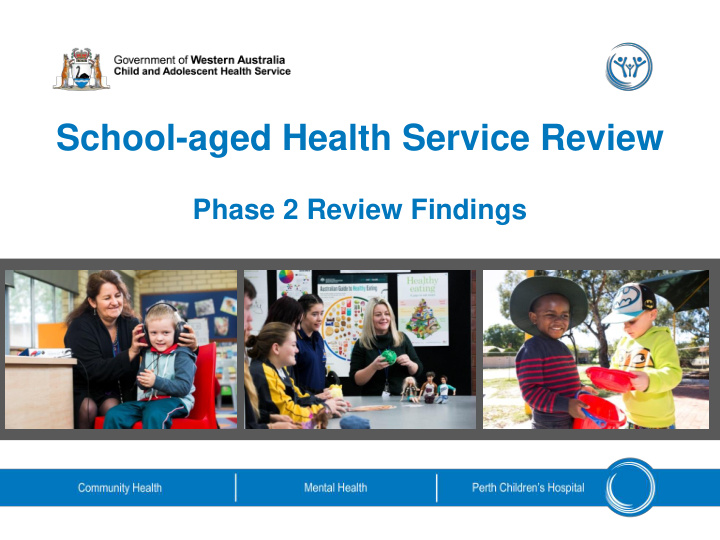



School-aged Health Service Review Phase 2 Review Findings
WA school health services Early Health Specialist detection promotion health expertise
WA school health services in numbers * Aboriginal Community Controlled Health Organisations
Review of school-aged health services To help ensure that school health services remain contemporary, are aligned to best practice, and continue to meet the needs of the school age population
Completed work - Phase 1 • Completed December 2017 • Consultation with consumers and school health staff (metropolitan and country) to help shape the review • Communication with high level stakeholders including Department of Education, Catholic Education, Independent schools • Developed Review Terms of Reference in collaboration with WACHS and DoE • Appointed Reviewers – Marie Tyrrell-Clark & Dr Kylee Cox
Completed work - Phase 2 • Literature review of models/frameworks indicated services for school-aged children should be: based on a platform of primary prevention child and family centred proportionate to consumer needs (e.g. progressive universalism) improving long term outcomes for individual children and their families.
Completed work - Phase 2 cont. • Reviewed previous consultation information about services • Staff conversations with CAHS-CH and WACHS • Consultation with: Consumer on-line survey (1,530 completed surveys) Department of Education Focus groups – metro and country • Final report completed • Phase 3 in progress
Review findings – nine conclusions
Conclusion One Community health services for school- aged children, young people and their families are based on the principles of primary prevention and should be universally accessible , but with enhanced access for those requiring a greater level of support . They form an essential part of the health system and play a key role in addressing improved health outcomes .
Conclusion Two Community health services provided to school-aged children, young people and their families must be more flexible and responsive . The services must be broadened beyond the physical school setting to reach the wider school community .
Conclusion Three School-aged community health services should start well before school entry and continue into primary school. The offer of a universal screening or assessment should remain a key element of the service model for children entering school.
Conclusion Four School-aged community health services should reorient to be more focussed on vulnerable children, young people and their families to maximise health and development outcomes.
Conclusion Five School-aged community health services need to be focussed on supporting children and young people with chronic or complex health conditions including, but not limited to: mental health and wellbeing obesity sexual health diabetes asthma
Conclusion Six Demand for nursing services for children and young people with complex and ongoing (chronic) health needs has exceeded current capacity and requires further review .
Conclusion Seven Consumers expect health information, advice and support to be available online and to be able to access services using 21 st century technology .
Conclusion Eight A highly skilled workforce is needed to deliver community health services to children, young people and their families.
Conclusion Nine Better measures of service outcomes are needed to communicate the trends , understand the issues and drive improvement in community health services for school-aged children, young people and their families.
Questions?
Recommend
More recommend